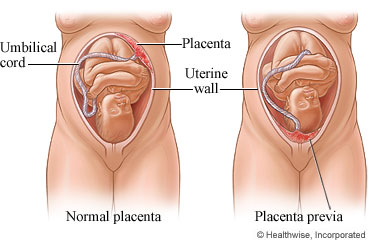Placenta Previa: Care Instructions

Overview
The placenta forms during pregnancy. It gives the baby nutrients and oxygen. It also removes waste products. Normally, the placenta attaches to the inner wall of the uterus, away from the opening of the uterus (cervix). Sometimes the placenta attaches so low that it blocks or partially blocks the opening. This is called placenta previa.
Painless bleeding is usually the first sign that the placenta is over the cervix. To find the position of the placenta, an ultrasound of the uterus is usually done.
The cause of placenta previa is often unknown. There are certain factors that can raise the chance of placenta previa. These include if you:
- Have a history of placenta previa, cesarean delivery, or uterine surgery.
- Are age 35 years or older.
- Smoke or use cocaine during pregnancy.
- Have had 3 or more babies.
- Are carrying twins.
- Have a health condition such as diabetes or high blood pressure.
- Have had in vitro fertilization for this pregnancy.
Your healthcare provider may recommend that you limit your activities. Your doctor or midwife will watch you closely until your baby can be safely delivered. Most of the time a caesarean delivery is needed.
Follow-up care is a key part of your treatment and safety. Be sure to make and go to all appointments, and call your healthcare provider or nurse advice line (811 in most provinces and territories) if you are having problems. It's also a good idea to know your test results and keep a list of the medicines you take.
How can you care for yourself at home?
- Watch for any vaginal bleeding or signs of labour.
- Follow your healthcare provider’s instructions about doing your routine activity or light exercise.
- Have a phone nearby at all times in case you need to call for help.
- Tell all healthcare providers who examine you that you must not have pelvic exams because you have placenta previa.
- Ask your healthcare provider if you can have sexual intercourse. It’s commonly recommended that if you have placenta previa not to have sexual intercourse after 28 weeks of pregnancy.
- Do not put anything, such as tampons or douches, into your vagina. Use pads if you are bleeding, and call your healthcare provider, midwife, or nurse advice line right away.
- Follow your healthcare provider’s instructions about how often to count your baby’s movements. For information on counting your baby’s movements, go to: Fetal Movement Count Chart (albertahealthservices.ca).
- Do not use tobacco or tobacco-like products, including cannabis, and other substances. They can harm your health. They also affect your baby’s growth, health, and the development of their brain and lungs. If you need help to use less or quit, talk to your healthcare provider, or go to the AlbertaQuits website.
- Do not drink alcohol. Alcohol affects everyone differently and may be a risk to your health. Alcohol passes through the placenta to your baby and can cause problems with their growth, health, and development.
Pregnancy can be an emotional and unpredictable time. When you have complications in your pregnancy you may have more stress. This can lead to other concerns for you and your family. Talk to your healthcare provider about how you’re feeling and any concerns you have.
When should you call for help?

Share this information with your partner or a friend. They can help you watch for warning signs.
Call 911 anytime you think you may need emergency care. For example, call if:
- You passed out (lost consciousness).
- You have severe or a continuous flow of vaginal bleeding.
- You have sharp or severe pain in your belly or pelvis that doesn’t get better or go away.
Call your healthcare provider, midwife, or nurse advice line now or seek immediate medical care if:
- You have any vaginal bleeding.
- You are dizzy or light-headed, or you feel like you may faint.
- You have pain in your belly, pelvis, or lower back.
- You think that you are in labour or are having contractions of your uterus with or without pain (6 or more in 1 hour).
- You have a sudden trickle or gush of fluid from your vagina.
- You notice that your baby has stopped moving or is moving much less than than 6 times in 2 hours.
- You have severe nausea or vomiting – vomiting more than 3 times a day or are too nauseated to eat or drink (especially if you also have fever or pain).
Watch closely for changes in your health, and be sure to contact your healthcare provider, midwife, or nurse advice line if you have any questions or concerns.
Where can you learn more?
Go to https://www.healthwise.net/patientEd
Enter A070 in the search box to learn more about "Placenta Previa: Care Instructions".
Adaptation Date: 01/18/2024
Adapted By: Alberta Health Services
Adaptation Reviewed By: Alberta Health Services
